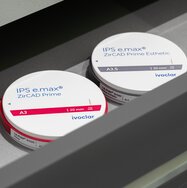The benefits of Prime Zirconia
Is zirconium oxide something that tickles your curiosity? If so, have a look at Prime Zirconia, which is a part of the e.max family. It will definitely be worth your while.
Successful all-ceramic assortment
IPS e.max is a popular and well-tried all-ceramic assortment that has been on the market for many years. When it was first introduced, the IPS e.max range included the lithium disilicate glass-ceramics (IPS e.max Press and IPS e.max CAD) and zirconium oxide (IPS e.max ZirCAD). Since then, the range of zirconium materials in particular has consistently been extended to include discs and blocks that feature enhanced properties to create natural looking[1] restorations. Just what are the real benefits of this material?
First benefit: excellent product quality
Monolithic zirconia restorations have become one of the most popular all-ceramic restorations due to their high flexural strength and fracture toughness.
As a dentist, you may not always be able to see the differences in the quality of zirconia materials. If you use a zirconium oxide material from Ivoclar, you can be sure to get a top-quality material – just as you have come to expect of the IPS e.max lithium disilicate glass-ceramic. Prime Zirconia too, offers you durability, stability and impressive esthetics. A consistently growing body of clinical studies have shown an excellent 5-year survival rate of 96 percent for restorations made of IPS e.max ZirCAD.
Given the material’s robust properties, the wall thickness of restorations can be significantly reduced and tooth-conserving preparation is possible.

Second benefit: versatility
Prime Zirconia materials cover a wide field of applications, ranging from crowns and (long-span) bridges to implant/abutment supported superstructures in both the anterior and posterior regions. Monolithic crowns and bridges can be easily characterized, glazed or polished. Coping and bridge frameworks are completed using the ceramic layering technique with IPS e.max Ceram in the dental lab.


Third benefit: coordinated translucency and strength
IPS e.max ZirCAD Prime and IPS e.max ZirCAD Prime Esthetic are the flagship materials of the zirconia range.
These two discs owe their high-performance characteristics to a unique manufacturing method – the Gradient Technology (GT). This technology combines two zirconia raw materials to produce a single material using a patented manufacturing process: High-strength zirconia (3Y-TZP in IPS e.max ZirCAD Prime and 4Y-TZP in IPS e.max ZirCAD Prime Esthetic) is combined with highly translucent zirconia (5 Y-TZP) to form a single disc.
Innovative processing steps provide the discs with a seamless, consistent progression of shade and translucency, a homogeneous microstructure and an overall enhanced translucency. The result is a material that offers an impressive esthetic effect.
IPS e.max ZirCAD Prime Esthetic (850 MPa in the dentin, 650 MPa in the incisal area.[2]) is the go-to material for natural-looking[1]. crowns and 3-unit bridges.
IPS e.max ZirCAD Prime offers a high degree of flexibility for versatile applications. Having a flexural strength of 1200 MPa in the dentin and 650 MPa in the incisal area.[3], the material is suitable for long-span bridges on natural or implant abutments.

Fourth benefit: various cementation options
When placing restorations made of Prime Zirconia, you generally can choose between adhesive, self-adhesive or conventional cementation techniques. Use the method that best fits the needs of your patient.
ZirCAD Cement is a conventional cement designed for the easy and economical placement of zirconia restorations. The cement offers predictable results and easy handling.
Once the occlusion has been finalized either intraorally or extraorally, the contact points of IPS e.max ZirCAD restorations are polished to a high gloss using OptraGloss.
Receive our monthly newsletter on recently published blog articles, upcoming education programs and exciting new product campaigns!
1 At natural lighting conditions. The use of artificially generated UV or UV-like light may result in a different impression.
2 Typical mean value of biaxial flexural strength 850 MPa (dentin) and 650 (incisal), R&D Ivoclar Vivadent AG, Schaan, Liechtenstein
3 Typical mean value of biaxial flexural strength 1200 MPa (dentin) and 650 (incisal), R&D Ivoclar Vivadent AG, Schaan, Liechtenstein


